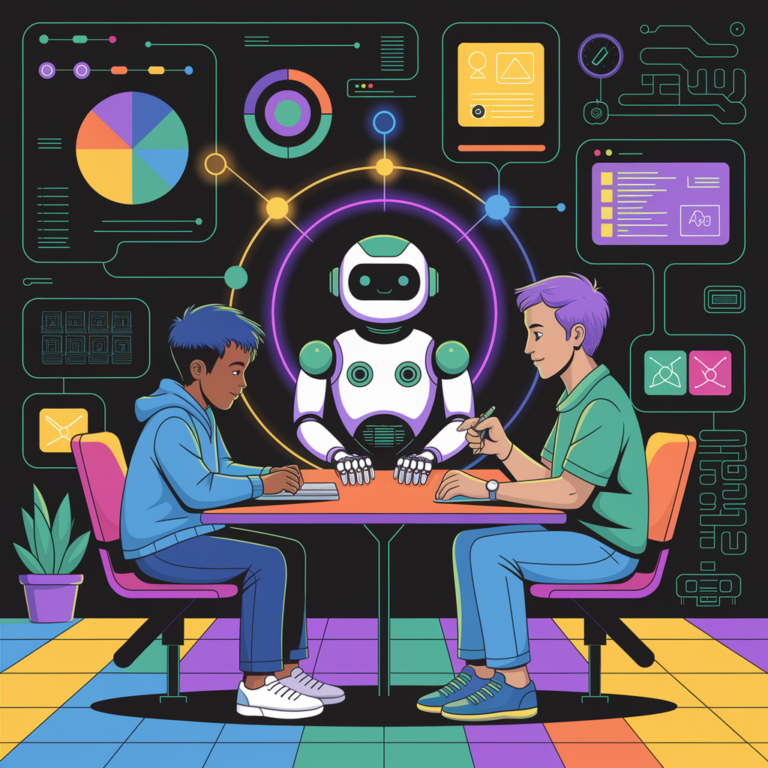Best AI Teaching Tools: Enhancing Education with Technology
According to a 2022 survey by the EdWeek Research Center, teachers spend an average of five hours per week grading assignments. They spend an additional five hours per week planning and preparing, and three more hours per week doing administrative tasks. That’s all outside the classroom!
Artificial intelligence can help to alleviate some of these responsibilities, offering tools that automate routine tasks, allowing teachers more time to engage with students, and enhancing the learning environment.
Whether used for lesson planning, testing, or interactive instruction, AI-powered applications provide valuable support for both educators and students. This guide explores some of the most effective AI tools available to teachers today and best practices for integrating them into the classroom.
Why AI Matters in Education
AI-powered tools help educators save time, reduce workload, and deliver more personalized instruction.
Key advantages include:
- Efficiency: Revise and edit assessments on the fly with carefully designed prompts.
- Personalization: Adapt lessons and assessments to suit different learning styles and student needs.
- Engagement: Use interactive AI-based platforms to create a more immersive learning experience.
- Support for Educators: Provide suggestions, insights, and recommendations to improve teaching strategies.
Top AI Tools for Educators
1. ChatGPT
Function: Assists with brainstorming, lesson planning, and providing writing feedback.
Use Case: ChatGPT can generate discussion questions, draft lesson outlines, and offer personalized writing suggestions for students. It can also be used to create quizzes, answer student inquiries, and support research-based assignments.
2. Grammarly
Function: AI-powered grammar, clarity, and plagiarism checker.
Use Case: Grammarly helps students improve their writing mechanics by offering real-time feedback on grammar, punctuation, and style. It can also help educators review student writing and provide constructive feedback efficiently. The new plagiarism and AI checkers can also be beneficial when used conscientiously.
3. Canva AI
Function: Assists in creating engaging visual content for lessons and presentations.
Use Case: Teachers can design eye-catching presentations, infographics, and educational posters effortlessly. Canva AI also provides templates for worksheets, flashcards, and social media graphics to enhance classroom communication.
4. Gamma.app AI
Function: AI-powered presentation and storytelling tool for creating visually engaging content.
Use Case: Gamma enables teachers and students to create interactive presentations, visual storytelling, and educational slides with ease, enhancing engagement and comprehension.
5. Khan Academy AI
Function: AI-driven tutoring platform for personalized education.
Use Case: Provides students with individualized tutoring sessions, guiding them through lessons with adaptive feedback. Teachers can track progress and assign targeted exercises to reinforce key concepts.
6. EdPuzzle AI
Function: Creates interactive video lessons with AI-generated questions.
Use Case: Teachers can transform video content into interactive learning experiences by embedding quizzes, comprehension questions, and discussion prompts within the videos.
7. Quizizz AI
Function: Generates AI-powered quizzes and gamified assessments.
Use Case: Teachers can create engaging assessments that provide instant feedback and insights into student performance, making learning more interactive and data-driven.
8. Formative.com
Function: AI-driven formative assessment platform.
Use Case: Formative.com enables teachers to create interactive assignments, provide real-time feedback, and track student progress through AI-powered insights. Formative.com helps educators personalize instruction and improve learning outcomes by analyzing student responses dynamically.
Best Practices for Using AI in Teaching
- Use AI as a co-teacher, not a replacement: AI should support, not replace, traditional teaching methods. Think of it as an assistant rather than an instructor.
- Encourage AI literacy: Teach students to critically evaluate AI-generated content rather than accepting it at face value.
- Ensure AI aligns with learning objectives: Before integrating an AI tool, ask: Does this enhance student learning and engagement?
- Prioritize data privacy: Choose AI platforms that comply with student data protection laws and ethical guidelines.
- Establish classroom AI policies: Define clear rules for AI use in assignments and assessments to maintain academic integrity.
Conclusion
AI tools can transform education by making teaching more efficient, personalized, and engaging. When used thoughtfully, they can provide invaluable support for both educators and students. By integrating AI into lesson planning, assessments, and student support, teachers can create dynamic, interactive learning environments that cater to diverse learning needs.
Looking for more AI-powered educational tools? Stay updated with our latest recommendations and resources!


